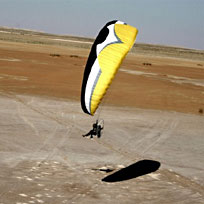|
|||||||||||||||||||||||||
Ozone Viper
Ozone Power Gliders:
RoadrunnerMoxiePWR Mojo Power 2 MojoMAX Kona 3 Roadster 4 RoadMAX Spyder 4 Freeride 2 Speedster 3 Sirocco 3 Viper XC Viper 6 MagMAX 3 MagMAXX Triox 2 Used Paragliders:
Ozone Power Gliderswww.FlyOzone.com 
|
The Viper is the world champion paramotor wing for expert pilots who fly in high level competitions and make advanced XC flights.
The high top speed, low sink rate and super high efficiency of the Viper all mean lower fuel consumption and longer, faster flights. The handling is direct and very precise, with clear feedback for increased thermalling performance. We hope expert pilots will immediately recognize the difference and will instantly appreciate the precision and performance of this wing. Launching is simple due to the benign inflation characteristics, allowing you to spend more time in the air and less time launching. We believe the Viper is leading the next generation of motor wings. Developed in cooperation with Mathieu Rouanet, World Champion 2005, the Viper excels in every aspect of motor flying from skimming the ground at low altitude to long distance high altitude flights with extraordinarily low fuel consumption. This Viper is an Open Class wing, and load tested to 1607kg on average, which means 11.5G for the 27 and 14G for the 24! This is exceptionally high, and the Viper is one of the stronger wings available today. Watch a video of the Viper in action: Viper Acro Interview with Mathieu Rouanet, PPG World Champion Pictures of the Viper on the TrikeBuggy Ozone Reflex Profile
Most PPG pilots today have heard about “auto-stable” or “reflex” airfoils. However, there is little information available on what exactly a Reflex Profile is and what it means to fly with one. PPG pilots are often concerned with speed, because higher speed allows more distance to be travelled in a shorter time. To maintain a high speed, the glider must fly at a lower angle of attack (AOA). However, a lower AOA makes a standard PG airfoil wing less stable. The “Reflex” airfoil acts like an automatic system to assist the wing in turbulence by adjusting the point of lift on the airfoil. As the glider’s AOA decreases, the lift point moves forward on the airfoil, increasing stability and lift and resisting collapse.
The reality of a flexible airfoil concept with suspension lines is that there is always potential of collapses, and although the “reflex” may delay the point where collapse is inevitable, it is still possible to hit strong enough turbulence to overcome any effect the reflex profile has and to then have a serious collapse. At this point, it is also important to mention that a collapse at a higher speed will invariably be more dynamic and more difficult to control. Also, in a collapse, the reflex profile tends to accelerate even more (shoot / dive forward) with the large increase of wing-loading that is a result of the decreased surface area of the wing during a collapse. A wing can have varying degrees of reflex in its profile. There are various parameters which the designer can work from to create a strong or light reflex profile, which means that some wings have more reflex in their profiles than others. Too much reflex in a wing’s profile may make it fast, but in the end you pay for that increase in speed with safety and stability, and also with handling, which tends to be poor in wings with high amounts of reflex. At Ozone, after thousands of hours of research and testing over the years, we have found what we think is the perfect blend of free-flight and paramotor profiles. The Ozone Reflex Profile, or OZRP, is the result.
Some other effects that reflex has on a wing’s character are: * Launching: The inflation is slower- the glider can be reluctant to come overhead and usually needs to be held with the A’s all the way up to be successful. Also, take off may require slightly more running than with a free-flight profile. In theory, the reflex profile is not the ideal solution for a high speed paraglider. Theoretically, the fastest profile is a symmetrical airfoil. The reflex is a solution that fits the needs of our flexible airfoil gliders with an acceptable amount of stability at low angles of attack (accelerated flight).
|
All the information and images published in this website are property of AmericanParagliding.com unless stated otherwise.
|
|||||||||||||||||||||||







